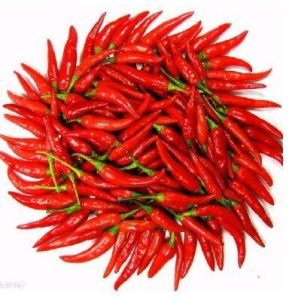
BY GETACHEW MINAS
The red pepper has several names in different parts of the world. It is the most commonly used for spicing food around the world, with some variation in accent. In some countries, red pepper is kept in flower pots to give flavor to food items. Central and South America are believed to be the sources of red pepper from where it spread to the rest of the world. It is also cultivated in Ethiopia, but here its share in the world is insignificant due to low productivity. According to Ethiopian Export Promotion Agency (EEPA), the history of pepper in Ethiopia is perhaps the most ancient than the history of any other vegetable products in the country.
The term spice refers to any dried plant product used primarily for seasoning, be it the seed, leaves, bark, or flowers. Spices are essential oils that give foods and beverages flavor, aroma, and sometimes color. They can be marketed whole, ground to a powder or in the form of essential oils. Many spices are also used for other purposes. Plants such as turmeric are increasingly in demand for natural therapies, while others such as peppers serve as substitutes for chemical dyes or pesticides as explained by M. Yimer. Another definition indicates that spice is a dried seed, fruit, root, bark, or vegetative substance used in nutritionally insignificant quantities as a food additive for the purpose of flavoring, and sometimes as a preservative by killing or preventing the growth of harmful bacteria.
As pointed out by W. Gobie, Ethiopians have a strong attachment to dark red pepper, which has high value for its pungency. The pungent product, in its fine-powdered form is an indispensable flavoring and coloring ingredient in the common traditional sauce known locally as “Wot”. The green pepper is consumed as vegetable with other food items. There is a general belief among Ethiopians that a person who frequently consumes hot pepper has resistance to various diseases. It is included in the daily diet of most Ethiopians, particularly during fasting days and Lent. The average daily consumption of red pepper by an Ethiopian adult is higher than most other vegetables.
Red pepper is cultivated in many parts of Ethiopia and it is an important source of income for smallholder producers. It is mainly produced for the export market though its share of the global market was insignificant. Red pepper production can be considered as underdeveloped, unorganized, small in scale, and inefficient. Its production is constrained by shortage of improved seeds, lack of technical advice and assistance, inconsistent fertilizer application leading to “delay” in sowing and harvesting. Red pepper production is also constrained by traditional cultivation, lack of training and shortage of manuals for use by development assistants. It is also largely hindered by shortage of publications and guidelines for spice production.
The red pepper enterprise suffers from small production, low quality, diminished value and irregular supply. Participants in its value chain are input suppliers, producers, traders, processors, wholesalers, retailers, and consumers. Any one of these actors may create problems related to quality and quantity. This may negatively impact on competitiveness of domestic and external traders. The decline of red pepper production is also attributed to poor varieties, cultural practices and plant diseases. Problems of production and marketing of red pepper have to be resolved if farmers are to benefit from it. Despite the significance of red pepper in the economy and its income-generating capacity, it has not been given due attention by policy makers.
Red pepper is an important vegetable ranking second after tomatoes. It is a type of spice used for flavoring and coloring food. The nutritional value of red pepper merits special attention as it contains essential vitamins and minerals, specially vitamins A and E. Both hot and sweet peppers contain more vitamin C to prevent flu. The color and flavor extracts from red pepper are used as condiment in food. The food industries use it for the production of ginger beer, hot sauce, and poultry feed. In some countries, the leaf tips of red pepper are cooked as herbs. Furthermore, in many households, red pepper provides the flavor that enhances the consumption of plain diets. The range of food products that contain red pepper or its chemical constituent is broad. It is used with traditional food, meat, salad dressings, mayonnaise, dairy products, and candies, packed foods, and hot sauces.
Red pepper is used as input for cosmetics, medicine and garden ornaments. It is the common ingredient of dish of most Ethiopians. People consume red pepper as an appetizer and supplement to household diets. Red pepper is a major spice and vegetable crop produced by most of the smallholder farmers in the country. Studies have been conducted to review the major red pepper marketing actors and their role in the economy. The major marketing channels and the factors affecting its growth and yield have also been identified. Many of these markets indicate demand for red pepper to be used for medication, religious rituals, perfumes, and for appetizers.
Red pepper is an annual crop which grows at an altitude ranging between 1400-2100 meters above sea level, with a rainfall between 600-650 mm. It requires soil that is well drained and rich in organic matter. Its cultivation depends on well-prepared soil that is free from perennial weed. It is disseminated by raising seedlings in a nursery. It is harvested within six months from transplanting. According to A. Abay, planting is carried out at the beginning of the rain season. The red pepper is harvested when it is fully red and partly dry. After harvesting, red pepper is dried in shades. It is one of the major vegetables and spices grown in Ethiopia.
The Ethiopian Institute of Agricultural Research (EIAR) has released five pepper varieties that are widely used by farmers. These varieties are highly demanded by spice factories. Red pepper is an important cash crop for many smallholder producers. It is a crop of high value in both domestic and export markets. It generates employment to both urban and rural workers. The processed red pepper is exported to different countries. The deep-red colored varieties have a very high local demand. The production of red pepper is constrained by variability of seasonal conditions. Its production and productivity are not constant, varying from one season to the next, depending on weather conditions.
The quality of red pepper is negatively affected by adulteration due to mixing it with foreign matters. Some merchants contaminate, pollute, and adulterate the quality of pepper by mixing it with sand, soil, and water. They do this to raise the quantity and price of red pepper. Lack of control has negatively affected the quantity and quality of red pepper which reduced the income of processing plants. Moreover, some of the traders sold red pepper to the local collectors on credit without advance payment. These collectors have to prepare high quality red pepper for the local and external markets. In doing so, they are forced to incur additional cost to maintain the quality of the red pepper.
Appropriate interventions are required to alleviate the problems mentioned earlier. These measures help in increasing production and productivity whatever the quality may be. All actors involved at each stage of the value chain should focus on mutual benefits. Among these actors are the cooperatives of red pepper producers that have to be involved in the marketing of the product. It is useful to capitalize on the existing opportunities as well as minimizing the challenges that hinder the red pepper development in the country. All actors in the value chain should be closely related to identify production and distribution problems in advance. The proper “linkage” in production, transporting, processing, storage, quality control and export promotion, financing and taxation and other related activities is crucial for promoting red pepper.
It should be recognized that red pepper is an important vegetable crop that is given high rank. It is a spice that gives flavor and color to food items. There are different factors that affect the production as well as the marketing of red pepper. The red pepper involves input suppliers, producers, collectors, brokers, processors, wholesalers, retailers, and final users. Even though there are different participants in the value chain, the distribution of benefit is not fair due to lack of integration among actors. Unlicensed and “illegal” traders buy the produce equally with licensed traders. The illegal traders sell the red pepper at lower prices, negatively affecting the licensed ones, who pay tax and meet other obligations. The illegal traders adulterate the quality of the produce for making wider margin of profit.
The production and distribution as well as the demand for and supply of red pepper are negatively affected by informal and unlicensed traders. These traders make a wide margin of profit at the expense of farmers. Also, being informal, they do not pay tax on the income they reap. To reverse this malpractice, producers need to be organized and benefit at each stage of the process, including input supply, collection, wholesale and retail trade. Also, those actors involved in the business should be made aware of the mutual benefits at each stage of the value chain.
The necessary infrastructure that facilitates the production and marketing of the produce should be in place to ensure benefits that accrue to all actors. Development agents have to assist farmers in solving problems related to yield and growth of productivity. These agents should also assist farmers in improving the quality of the produce by minimizing adulteration. With improved quantity and quality of produce, farmers may earn better income. Similarly those engaged in marketing of the produce at the international level may earn better income through competition that result in higher foreign exchange for the country at large.
Those actors involved in the value chain should remove low quality of the produce that lead to diminished value. Similarly, irregular input supply has negative effects on the production process that disrupts the interconnection between producers and traders. Output processing requires washing, cleaning, drying and packing for the local and external markets. Processed red pepper should be verified for its quality before it is packed by retailers and wholesalers. Domestically, the red pepper enterprises create employment and income and generate tax revenue. These enterprises should, therefore, be encouraged by the government at all levels.
The Ethiopian Herald August 5/2021




